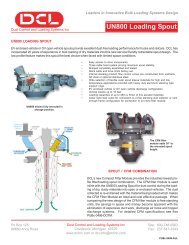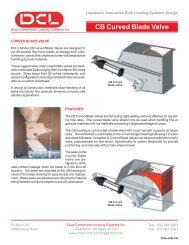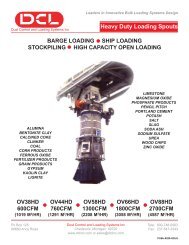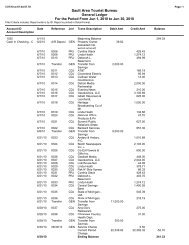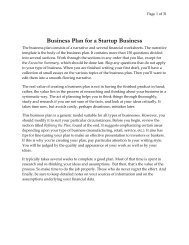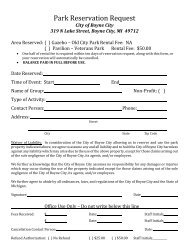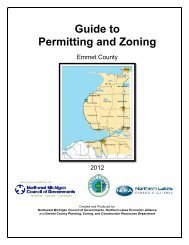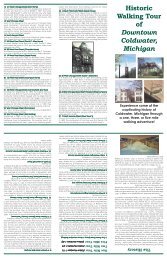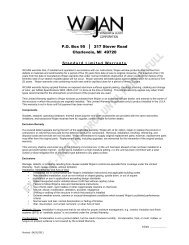Aeration Conveying Equipment - Air Process Systems & Conveyors ...
Aeration Conveying Equipment - Air Process Systems & Conveyors ...
Aeration Conveying Equipment - Air Process Systems & Conveyors ...
You also want an ePaper? Increase the reach of your titles
YUMPU automatically turns print PDFs into web optimized ePapers that Google loves.
Dust Control and Loading <strong>Systems</strong> Inc<br />
Po Box 125<br />
08660 Ance Road<br />
Leaders in Innovative Bulk Loading <strong>Systems</strong> Design<br />
<strong>Aeration</strong> <strong>Conveying</strong> <strong>Equipment</strong><br />
CONVEYORS BIN BOTTOMS LUMP TRAPS<br />
TROUGHS SILO PENETRATION ADAPTORS<br />
ROTARY THROTTLE & VERTICAL SLIDE GATE VALVES<br />
ADIPIC ACID, ALUMINA, BENTONITE, BARIUM SULFATE, BAUXITE, CALCIUM CARBONATE,<br />
CALCIUM PHOSPHATE, CARBON BLACK, PORTLAND CEMENT, CLAYS, PULVERISED COAL, DOLOMITE,<br />
FELSPAR, FLOUR, FLOURSPAR, FLY ASH, FULLERS EARTH, GYPSUM, IRON POWDER, KAOLIN CLAY, LIME,<br />
PULVERIZED LIMESTONE, MAGNESIUM OXIDE, MAGNETITE, MAGNESITE, PULVERIZED ORES, PERLIGHT DUST,<br />
PETROLEUM COKE, PHOSPHATE DUST, PLASTIC POWDER, PVC RESIN, POTASH, POZZOLAN, PYROTOL,<br />
FOUNDRY SAND, SEMOLINA, SILICA, SODA ASH, SODIUM BICARBONATE, SODIUM SULFATE, STARCH,<br />
STUCCO, TALC, TEREPHALIC ACID, WHITING, ZINC OXIDE<br />
Dust Control and Loading <strong>Systems</strong> Inc<br />
Charlevoix, Michigan 49720<br />
www.dclinc.com or sales@dclinc.com<br />
Tele: 800-748-0563<br />
Fax: 231-547-3343<br />
PUBc-0404-FC
Aerated bin bottom discharging<br />
into a conveyor with slide gate<br />
valves.<br />
Aerated distribution box with<br />
four discharges.<br />
Aerated lump trap with slide<br />
gate valve.<br />
www.dclinc.com<br />
231-547-5600<br />
To learn more about<br />
our other product lines,<br />
please visit our website<br />
or give us a call.<br />
800-748-0563<br />
sales@dclinc.com<br />
AERATION EQUIPMENT OVERVIEW<br />
Under normal conditions a powder runs down a chute only when the slope exceeds<br />
the natural angle of repose of the powder. A fluidized powder however, runs<br />
down a chute which has an angle much less than the natural angle of repose of the<br />
powder. The principle of air gravity conveying involves the reduction of the natural<br />
angle of repose of a pulverized material to a fluidized angle which is slightly<br />
less than the angle of declination of the conveyor. This is accomplished by passing<br />
low pressure air through a porous membrane and into a bed of pulverized<br />
material.<br />
A large variety of materials are handled on aeration conveyors regardless of their<br />
abrasive nature or bulk density. The only criteria is particle size and moisture.<br />
Generally, a product should have a particle distribution of 100% through a 20 mesh<br />
screen. It is possible to convey coarser materials provided there is a greater percentage<br />
of fine material to fill the voids. Free moisture content should be below<br />
1%, however materials with higher moisture contents have been conveyed. With<br />
some materials, the characteristics of particles may make aeration impossible or<br />
uneconomical. A powder that can be fluidized usually possess the characteristic<br />
of flowing freely through the fingers, feeling clean and dry, and not flaky or fibrous.<br />
<strong>Aeration</strong> conveyors are used to convey products<br />
from point A to point B by using aeration<br />
and gravity. Minimum suggested conveyor<br />
angle is 8 degrees, but may be as low as 6 degrees<br />
depending on product material type.<br />
Turning boxes, headchutes, and distribution<br />
boxes are available to use in conjunction with<br />
aeration conveyors.<br />
<strong>Aeration</strong> lump traps are a ideal when large<br />
lumps are present in material. Lumps are generally<br />
created in the silo by moisture and are<br />
typically unacceptable for the consumer's vehicle<br />
being loaded. The lump trap eliminates<br />
large lumps by creating a gravity trap in-line<br />
with a aeration conveyor. This is accomplished<br />
by passing low pressure air through a overlapping<br />
configuration of porous membrane<br />
media and into the bed of the material being<br />
handled. Heavy lumps fall and are caught in<br />
the bottom of the lump trap which automatically<br />
empties using a level sensor accompanied<br />
by a series of slide gate valves.<br />
AERATION CONVEYORS<br />
DCL offers a large selection of aeration conveyors<br />
from 6 inches [152 mm] wide up to 36 inches [914 mm] wide and conveying<br />
capacities up to 1000 cubic feet per minute [28.3 m³/min]. <strong>Conveyors</strong> also are available<br />
in a high top or low top design allowing for maximum flow rate or minimum<br />
head room depending on the application.<br />
AERATED LUMP TRAPS<br />
DCL offers a selection of aeration lump traps from 6 inches [152 mm] wide up to 36<br />
inches [914 mm] wide and conveying capacities up to 1000 cubic feet per minute<br />
[28.3 m³/min]. Lump traps also are available in a high top or low top design allowing<br />
for maximum flow rate or minimum head room depending on the application.
AERATED BIN BOTTOMS AND TROUGHS<br />
<strong>Aeration</strong> bin bottoms are used to promote consistent<br />
product withdrawal from large diameter<br />
flat or conical bottom storage silos.<br />
DCL offers a large selection of aeration bin bottoms<br />
from 2 feet [610 mm] in diameter up to 16<br />
feet [4.9 m] in diameter. Bin bottoms are also<br />
available with custom discharge configurations<br />
allowing for multiple conveyor runs from<br />
one silo.<br />
Troughs are typically mounted inside the conical<br />
section of the silo and are equally spaced<br />
along a 360 degree pattern. However they can<br />
also be used in flat bottom silos and only require a 6 degree slope from the inner<br />
silo wall of the silo to the discharge point.<br />
DCL offers a selection of aeration troughs from 6 inches [152 mm] wide up to 24<br />
inches [610 mm] wide.<br />
SILO PENETRATION ADAPTORS<br />
<strong>Aeration</strong> silo penetration adaptors allow material<br />
to be withdrawn from the side of any silo. They<br />
can be easily retrofitted in the field to existing silos<br />
when silo bottom discharges are not possible.<br />
DCL offers a large selection of aeration silo penetration<br />
adaptors from 6 inches [152 mm] wide up<br />
to 36 inches [914 mm] wide and conveying capacities<br />
up to 1000 cubic feet per minute [28.3 m³/min].<br />
FLOW CONTROL VALVES<br />
Rotary throttle valves are a excellent means to<br />
control material flow while air gravity conveying.<br />
The rotary throttle valve uses a rotary<br />
parabolic blade that allows for<br />
a low profile design that delivers<br />
precise flow control. A 4-20m electric<br />
actuator is used to actuate the<br />
valve when real time infinite positioning<br />
is required. If real time infinite<br />
positing is not required DCL<br />
uses a pneumatic actuator with a 3 position positioning package.<br />
Vertical slide gate valves are used in applications where a material<br />
flow shut-off is required in air gravity conveying applications. The<br />
vertical slide gate uses a Blanchard ground chamfered blade. Not<br />
only can the it be used to shut-off material flow, it can be used as a<br />
flow control.<br />
30’-0” diameter fully aerated flat<br />
bottom silo using aeration<br />
troughs.<br />
Vertical manual and pneumatic<br />
slide gate valve.<br />
<strong>Aeration</strong> conveyor run.<br />
Visit Our Website!<br />
www.dclinc.com
CAPACITIES<br />
<strong>Aeration</strong> conveyors can handle products varying in bulk density from 5 to 200 pounds per cubic feet at capacities to<br />
55,000 cubit feet per hour. Materials will expand in volume or decrease in bulk density while in the aerated state. A<br />
“Rule of Thumb” for calculating material expansion is to use a density decrease factor of .66. In other words,<br />
cement weighing 90 PCF at rest would weigh 90 X .66 = 60 PCF in a well aerated state. It is important to keep this in<br />
mind when selecting the conveyor size.<br />
Approximate conveying capacities in cubic feet per hour are listed below.<br />
Conveyor Size 6 8 10 12 14 16 18 20 22 24 30 36<br />
Cubic Feet Per Hour 1500 4000 5000 9000 12000 15000 21000 27000 33000 39000 57000 75000<br />
ANGLE OF DECLINATION<br />
Since one of the purposes of using an air gravity conveyor is to obtain near horizontal conveying, the angle of<br />
decline is usually held to a minimum, consistent with low fluidizing air flow and pressure requirements. Fluidizing<br />
characteristics determine the minimum slope of the conveyor. Most product suitable for air gravity conveying are<br />
handled on a conveyor sloped at between 6 and 12 degrees. The slope can be reduced to 1 or 2 degrees for product<br />
which have excellent fluidizing characteristics. Please note that there is no limit as to the length of any conveyor, so<br />
long as the proper slope is available.<br />
FLUIDIZING AIR<br />
The volume of free air required for most applications is approximately 10 SCFM per square foot of conveying media<br />
when handling a product like cement, fly ash, phosphate rock dust, and lime products. However the air requirements<br />
may vary for other materials from 4 to 15 SCFM per square foot. In conveying alumina and bauxite, the air<br />
requirement for fluidization can be as little as 4 SCFM. Please be aware that there is no definite formula for calculating<br />
the volume of free air required. In order to establish the proper air requirements for materials not previously<br />
handled, DCL offers testing at their facility. The pressure required to convey a material having a loose bulk density<br />
of approximately 70 PCF or less is about 20 inches of water gauge in the plenum chamber while materials having a<br />
loose bulk density over 70 PCF will use 27 inches of water gauge. <strong>Air</strong> pressure for open type conveyors installed in<br />
silos or hoppers are generally determined by the head of product over the conveyor. A head of 2 FT = 1 PSI; 2-15 FT<br />
= 2 PSI; 15-25 FT = 3 PSI; 25+ FT = 6 PSI. A general exception to this rule is alumina for which a pressure of 3 PSI is<br />
adequate regardless of head.<br />
Low pressure of up to 1 PSI can easily be supplied by a centrifugal blower. Pressures greater than 1 PSI should be<br />
supplied by a positive displacement blower. A high pressure air compressor or plant air is not recommended for use<br />
in supplying fluidization air as this source is considered “dirty air” meaning the presence of water and oil. The<br />
prevention of blockage of the porous membranes such as dirt, oil or moisture on the underside of the aeration media<br />
is so important that special attention should be given to the selection of air filters on the supply units. The best type<br />
of filters are an oversized, washable, dry type filter having a felt media. An oil wetted filter is not recommended. The<br />
filter selected should include a weather hood or screen depending upon blower location. Under no circumstances<br />
should the air blower be operated with the filter removed.<br />
Po Box 125<br />
08660 Ance Road<br />
Dust Control and Loading <strong>Systems</strong> Inc<br />
Charlevoix, Michigan 49720<br />
www.dclinc.com or sales@dclinc.com<br />
Tele: 800-748-0563<br />
Fax: 231-547-3343<br />
PUBc-0404-FC




